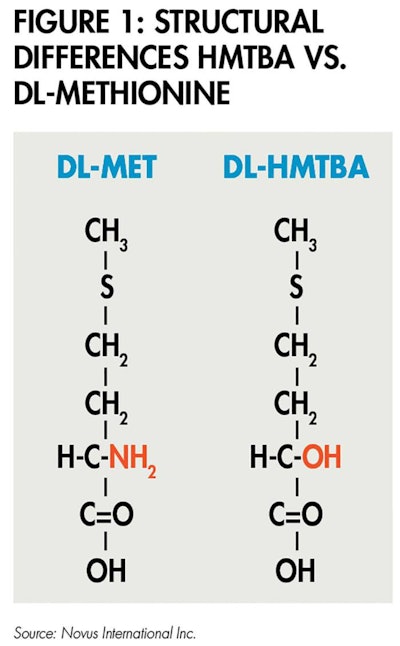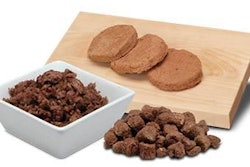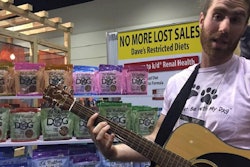
Sulfur-containing amino acids are nutritionally essential to animal growth, but many foods contain insufficient quantities. In addition, sulfur amino acids and lysine are the most susceptible of amino acids to processing damage from the manufacturing of diets. Amino acid supplementation is an important step in balancing pet food diets for an ideal amino acid profile. According to the 2006 US National Research Council (NRC, 2006), methionine is generally the most limiting (and, therefore, most important) amino acid in a diet formulated using natural ingredients for cats and is often first or second limiting for dogs.
The industrial application of synthetic sources of amino acids for animal feed has been occurring for over 50 years. For methionine, two sources make up the bulk of the commercial market: DL-methionine (DLM), a 50-50 mixture of D- and L-methionine, and 2-hydroxy-4-(methylthio) butanoic acid (HMTBa), a methionine precursor. For pet foods high in vegetable or lamb protein, supplemental methionine may be warranted to prevent deficiency symptoms due to poor availability of amino acids. Methionine can also be added to pet foods to support urine acidification and/or promote palatability.
Studies in pets, as well as poultry and swine, demonstrate key differences between HMTBa and DLM. First, DLM and HMTBa are chemically different products. HMTBa has a hydroxyl (OH) group at the asymmetric carbon where DLM has an amino group (NH2) (see Figure 1). The hydroxyl group makes HMTBa an organic acid. It occurs in animals as part of normal methionine and thio-methyl metabolism (Dibner et al., 1990). Organic acids have anti-microbial activity and are more effective acidifiers than amino acids.

HMTBa has a hydroxyl (OH) group at the asymmetric carbon where DLM has an amino group (NH2).
Second, HMTBa is metabolized differently.Once ingested by the animal, both D- and L-methionine are transported across the intestinal wall primarily via active and carrier-mediated transport, using energy and sodium-dependent transporters and energy and sodium-independent transporters. (Knight et al., 1994) (see Figure 2). Once absorbed, L-methionine is directly incorporated into protein. The D-methionine is converted into L-methionine in a two-step process. During the first step, an enzyme removes the amine group from the molecule. During the second step, another enzyme reattaches an amine group to create L-methionine.

Once ingested by an animal, both D- and L-methionine are transported across the intestinal wall primarily via active and carrier-mediated transport.
Conversely, the D- and L-isomers of HMTBa are transported across the animal’s intestinal wall mainly by diffusion, an energy-independent form of absorption. Once absorbed, the analogue also undergoes a two-step process to be converted into L-methionine. In the first step, an enzyme removes the hydroxyl group from the molecule. During the second step, another enzyme reattaches an amine group to create L-methionine (see Figure 3).

The D- and L-isomers of HMTBa are transported across the animal’s intestinal wall mainly by diffusion, an energy-independent form of absorption.
The L-methionine molecules derived from D-methionine or methionine hydroxy analogue can then be used by the animal to build protein.
Most pet foods exceed the animal’s protein and amino acid requirements by a significant margin. However, it is critical to balance for an ideal amino acid profile (Baker and Czarnecki, 1991) and sulfur amino acid addition may be necessary, despite protein excess. Excess protein cannot be utilized and is excreted. This excess is not only a wasted expense, but can have a detrimental effect on animal health. HMTBa has antimicrobial properties (not true for DLM) and is a better antioxidant [increased glutathione (Swennen et al., 2011; Li et al., 2014), increased taurine (Martin-Venegas et al., 2006; Fang et al., 2010b; Yodseranee and Bunchasak, 2012) and decreased homocysteine (Xie et al., 2007)] at similar levels of addition compared to DLM. Therefore, HMTBa may be beneficial in counteracting the detrimental effects of protein excess, resulting in improved gastrointestinal health in pets.
HMTBa has also shown positive benefits to urinary tract health over DLM. The two most predominant uroliths or stones in cat urine are struvite (49%) and calcium oxalate (39%) (SACNV 2010). Decreasing urine pH (pH < 6.5) is the most reliable means of decreasing risk for struvite.
There are two forms each of DL-methionine and HMTBa sold commercially. DL-methionine is sold both as a powder product that contains 99% DL-methionine and as a liquid product that contains 40% DL-methionine. HMTBa is sold as a liquid product that contains 88% HMTBa and as a powder product that contains 84% HMTBa and 12% calcium.
DL-methionine and methionine hydroxy analogue are different molecules and are absorbed differently by the animal. In the end, however, both molecules are efficiently and completely converted to L-methionine for use by the animal. When choosing a methionine supplement, HMTBa can help purchasers diversify their methionine choices and serve as a viable solution for methionine supplementation.
The efficacy of ALIMET and MHA vs. DL-methionine for the prevention of stones in cats
A recent study by Novus International Inc. compared the efficacy of liquid (ALIMET feed supplement) and dry (MHA feed supplement) 2-hydroxy-4-(methylthio) butanoic acid (HMTBa) vs DL-methionine (DLM) for the prevention of uroliths or stones, as well as their effect on urine pH in adult cats. As shown in Figure 4, urine specific gravity and urine pH were lowered by the addition of liquid (ALIMET) and dry (MHA) HMTBa, but not DLM. More importantly, the range in urine pH was much tighter and less variable for liquid and dry HMTBa compared to DLM and the control.

















